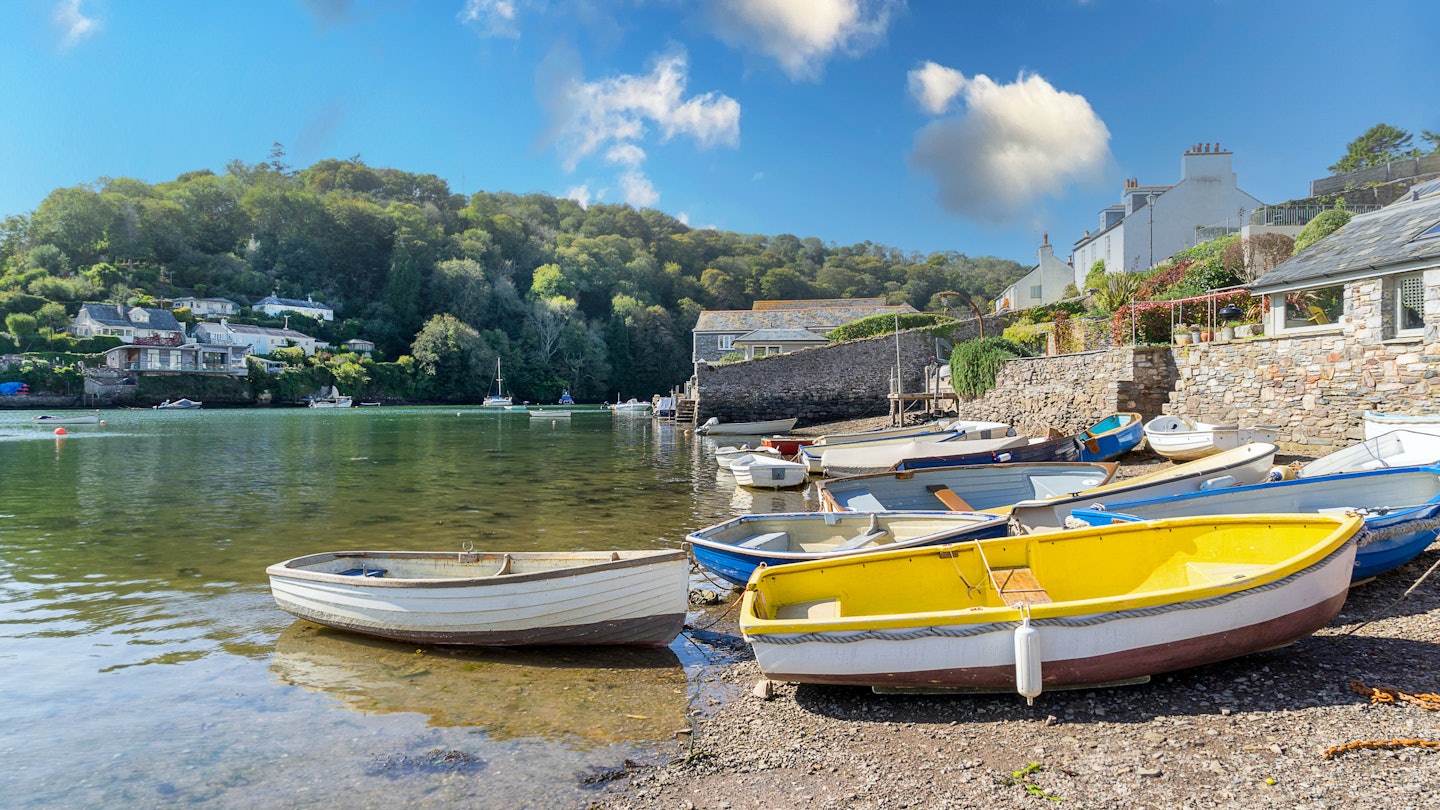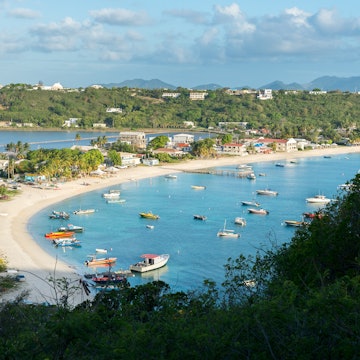
The 19 best things to do in Devon, England



From moorland to maritime culture, Devon is a fascinating corner of England to experience. Gordon Bell/Shutterstock
With its rippling, beach-fringed landscape, Devon is studded with historic homes, vibrant cities and wild, wild moors. On a trip to this special pocket of England, you can hike rugged coast paths, take scenic boat trips and get lost in hedge-lined lanes.
Discover collegiate Exeter, popular Torquay, yachting-haven Dartmouth, bewitching Salcombe and progressive-spirited Totnes. Outside of town, you can escape to wild Dartmoor and the remote, surf-dashed north coast. You can sample wines made from Devon vines and food that’s fresh from the field, furrow or sea.
However you decide to explore – surfing, cycling, kayaking, sea swimming or beachcombing – visiting Devon might feel like coming home.

1. Hit the waves at Croyde beach, Devon’s surfing hot spot
Croyde is a quaint coastal village where whitewashed thatched cottages meet laid-back surfer vibes; the choice waves on its crescent of sandy beach have been drawing surfers here since the 1920s. Today, the village – set within an Area of Outstanding Natural Beauty, a Marine Protected Area and the UK’s only World Surfing Reserve – is Devon’s surfing hub.
Experienced surfers can hit the waves at Croyde beach or (depending where the surf is) a nearby spot like Saunton Sands, Woolacombe or Barricane Beach. Boards can be rented from the local surf schools or from Ralph’s Surf Shop. For beginners, there are several surf schools in town, with Surfing Croyde Bay and Surf South West two of the best.
Planning tip: If surfing is more of a spectator sport for you, watch the pros from Surfing Croyde Bay’s funky sea-view cafe. Or walk the cliff path around to Baggy Point for views of the bay, returning via Putsborough for one of the area’s best coastal walks.
2. Hike the rugged Hartland Peninsula
A rugged jot of land at the very edge of Devon, the Hartland Peninsula is an often-forgotten realm of unspoiled coastline, sleepy farmland and pockets of ancient woodland. Hit the coast paths for hiking; try the loop trail through Brownsham Wood to Mouthmill Beach, where you can hop over rock pools to reach the triangular arch of Blackchurch Rock. For a challenge, the section of the South West Coast Path from Hartland Quay to Bude is considered one of the toughest – but among the most beautiful – parts of the trail.
Hartland Point has unbeatable views across the Bristol Channel to Lundy Island, directly opposite. While it’s not possible to walk to the tip of the point, you can follow the coast path up to the coastguard station to look down at the 19th-century lighthouse perched on rust-colored cliffs.
Planning tip: Bring binoculars: as well as bird-spotting on the peninsula, seals often hang out on the beaches below.

3. Join a kayaking tour of the Jurassic Coast
Running from Orcombe Point to Old Harry Rocks, the 95-mile (153km) Jurassic Coast is the only place on the planet where rock from the Triassic, Jurassic and Cretaceous periods can be seen in one place. Its geological significance earned the region UNESCO World Heritage status in 2001.
On a guided tour along the Jurassic Coast with Sea Kayak Exmouth, you’ll get an exciting, up-close view of the area’s impressive red cliffs and striking geology. Gentler paddles up the Exe Estuary provide a chance to spot gray seals, sandpipers and avocets.
4. Visit historic Exeter
Founded 2000 years ago by the Romans as Isca Dumnoniorum, Exeter is a city where history awaits around every corner. Centuries on, some 70% of the town’s Roman walls still stand, alongside a Norman castle, a monumental twin-towered cathedral, a medieval guildhall and plenty of gabled Tudor architecture.
This is a city that has lived many lives – as a Roman fort town, as one of Alfred the Great’s fortified strongholds and as the heart of Devon’s massive wool industry, to name just a few. Today, it’s a lively university town with a buzzy nightlife, a vibrant arts scene and a plethora of independent businesses. Foodies shouldn’t miss the weekly farmers market, held every Thursday morning on the corner of South and Fore Sts.
Planning tip: From local live music to large-scale festivals, there’s always something going on in Exeter. Check the calendar of events to find out what’s happening when you visit.

5. Wander Clovelly, Devon’s prettiest town
Whitewashed cottages zigzagging down the forested slopes of a plummeting cliffside toward a curved harbor: Clovelly feels like it was designed purely with postcards in mind. The steep cobbled streets can’t accommodate cars, which makes the center of Clovelly Historic Village strictly pedestrianized for an enticing “lost in time” feel. Deliveries are dragged downhill on wooden sleds. The Clovelly donkeys, who once carried supplies in and fisherfolk hauls out, now spend their days posing for photos at the historic stables.
Make your way downhill past craft workshops and quaint shops to reach Clovelly Quay, where the sea wall affords the best views of the hill-hugging hamlet. Clovelly’s two museums are worth a short visit: the Kingsley Museum (former home of The Water Babies author Charles Kingsley) and the cramped and atmospheric Fisherman’s Cottage.
Planning tip: There's an admission charge to visit the village, which covers parking, entry to both museums and the nearby Clovelly Court Gardens. This somewhat controversial-feeling fee helps raise money for ongoing conservation.
6. Try e-foiling and wingsurfing in Devon
Most visitors flock to Exmouth for its 2 miles (3.2km) of golden sand and long, scenic promenade. But there’s another, more thrilling side to this seaside town: Exmouth is one of South Devon’s best water-sports destinations.
Known as the “Duckpond,” the Exe Estuary’s flat waters and constant winds make it a prime spot for beginner kitesurfing and windsurfing. Edge Watersports offers lessons from entry level to instructor training, as well as equipment hire for those with experience.
Planning tip: For something completely different, you can book lessons to try out the latest crazes in adventure sports: e-foiling and wingsurfing. Turn up to find out more.
7. Walk a stretch of the South West Coast Path or East Devon Way
You’ll also gain a real appreciation for the Jurassic Coast (and its heights) by walking a section of the South West Coast Path. The stretch from Exmouth to Seaton is around 23 miles (37km), though there are plenty of shorter circulars to choose from. (The Orcombe Point Geoneedle is a good starting point.) Coastal highlights include the wildlife-rich salt marshes around the Otter Estuary, the views from the aptly named High Peak and the exposed white cliffs at Beer.
Inland from the Jurassic Coast, the East Devon Area of Outstanding Natural Beauty (AONB) is a quiet haven of woods, heaths and farmland. The East Devon Way forms its backbone: a 40-mile (64km) walking trail charting a meandering course from Exmouth to Lyme Regis, connecting many of the AONB’s gems. Depending on your pace, it’s possible to walk the whole thing in two days, but the official guide splits the route into six stages.
Local tip: If you only want to walk a small section, consider the 3-mile (4.8km) walk from Aylesbeare Common to Woodbury Castle, an Iron Age hill fort overlooking the Exe Estuary. The common is bursting with rare butterflies and birdlife, including Dartford warblers, stonechats and nightjars.

8. Join the yachtie crowd in Salcombe
Pretty, chic and just a tad bougie, Salcombe is one of Devon’s major sailing towns. Perched on the tranquil Kingsbridge Estuary, this yachtie haven is crammed with independent shops and more galleries than a town could possibly need. You’ll find them along Fore St, a long stretch of historic stone cottages running parallel to the river packed with galleries, nautical clothing brands and upscale boutiques.
Island St is home to even more galleries – as well as several of Salcombe’s independent producers, including the iconic Salcombe Dairy ice cream and chocolate factories. Grown-ups will want to seek out Salcombe Gin, firmly established as one of the county’s best; visit its riverside distillery for a tour and tasting. Right next door, the Devon Rum Company offers tastings at its waterside Blending House.
Planning tip: Love gin? Book a course at Salcombe Gin School, where you’ll use a mini copper still to distill your very own bottle.
9. Comb the beaches along Devon’s coast
Hidden coves, wooded inlets, sandy harbors, epic bays: southwest England has a beach to suit all moods. And around the coastline of Devon, you’ll find everything from busy bucket-and-spade resorts to secret spots known only to a chosen few. Some are easy to reach; others take time, dedication and a hike along the coast path (decent map in hand) to discover. Just don’t forget to pack the fins and snorkel.
Beaches worth adding to your Devon bucket list include the golden sandy beaches (rare in East Devon) at Exmouth. Also seek out Sandy Bay Beach, a small, sandy bay ideal for swimming. Named for the wooden staircase leading down to it, Jacob’s Ladder Beach is a sand and shingle beach in Sidmouth protected by towering red cliffs. At Beer there is a small, sheltered bay with a white-shingle beach backed by rugged white cliffs. And Seaton offers calm waters and plenty of amenities, making its beach a family favorite.
Planning tip: You can search for fossils near the cliffs around Seaton Hole.

10. Tour Plymouth’s maritime history by foot
For decades, some dismissed Plymouth as sprawling and ugly, filled with architectural eyesores and palpable poverty. Yet ongoing regeneration of its historic waterfront have made people rethink their assumptions. You can learn more about the city and its long maritime history by taking a walking tour.
Start at the striking Victorian-era Guildhall at the heart of the city, then follow Armada Way down to reach the Hoe, a clifftop park with unbeatable views of Plymouth Sound and several notable sights. Pause for views from the top of the Belvedere (aka the Wedding Cake), a grandiose Victorian structure with three tiers of colonnaded terraces, then take the steps down to follow the coast road around towards Sutton Harbour. Follow Southside St into the Barbican, an area of cobbled streets, historic architecture and quirky shops. Then return via the picturesque New St and end at the Mayflower Museum, where you can learn more about the story of the Pilgrim Fathers, and the history – and impact – of English colonization.
Finally, head inland explore Plymouth’s showstopping museum and art gallery The Box. Inside, permanent exhibits tell the story of England’s “Ocean City,” from the vast ship figureheads in the lobby to the excellent 100 Journeys exhibition that highlights the momentous voyages that have set out from Plymouth over the centuries.
Detour: On sunny days, head to Tinside Lido, a striking art deco outdoor pool overlooking Plymouth Sound.

11. Taste Devon’s best wines
Devon is home to some top-notch wineries, whose still and sparkling vintages win awards thanks to the region’s relatively mild climates and fertile soils. Many vineyards also welcome visitors for tastings, tours, and scenic countryside experiences. Quite possibly Devon’s finest, Sandridge Barton Winery is home of Sharpham Wines and offers tours and tastings. It’s about 5 miles (8km) from Totnes and can be reached by bus or taxi (or you can bring your own designated driver).
You can get hands-on at Tamar Valley Vineyard, where visitors can volunteer to get involved at this riverside vineyard. Alongside the vines at Calancombe Estate, a thriving kitchen garden supplies the estate’s restaurant with fresh, seasonal ingredients. A particularly pretty, family-run vineyard, Alder Wine is known for its excellent cafe. And Old Walls Vineyard is a well-established vineyard in the fertile Teign Valley with stunning countryside views – especially from the restaurant terrace.
12. Discover sustainable living in Totnes
At the top of the Dart Estuary, Totnes is a charming market town with a unique twist: this is one of the most ethical places in Britain. In 2006 Totnes was one of the first towns in the UK to declare itself a Transition Town, also becoming a Fairtrade Town in 2011. You can see what these designations entail by strolling Totnes’ historic High St to discover a collection of zero-waste shops, independent boutiques and vegan cafes. (Don’t miss the colonnaded Tudor buildings while you’re there.)
Soak up panoramic views of the Dart Valley from Totnes Castle, a 900-year-old Norman “motte and bailey” earthwork castle with a circular stone keep (added in the 13th century). Look out for arrow slits in the stone walls and the tree in the bailey which has graffiti carved by prisoners during WWII.
Detour: Visit the nearby Dartington country estate for walks in the Grade II–listed gardens.

13. Soak up the vibes of Torquay and the English Riviera
Looking out at the glittering spread of Tor Bay, it’s easy to see how the English Riviera became one of Britain’s most popular seaside resort areas. Spread along the wide bay, Torquay, Paignton and Brixham owe their thriving tourist industry and collective name to the Napoleonic Wars (1803–15): with France blockaded by the Royal Navy, the wealthy turned to the warm, sheltered waters of Tor Bay as a replacement for the French Riviera.
As its popularity boomed, the Victorians transformed Tor Bay, building grand villas and parks. Today, the glamor and glitz have faded a little, but the area remains a beloved seaside destination. Torquay, an interesting mix of shabby and chic, retains a touch of its former grandeur, while cheap-and-cheerful Paignton’s retro seafront plays more to families and coach-holiday crowds. To the west, Brixham’s working fishing harbor feeds Tor Bay’s growing foodie reputation.
14. Visit the home of Sir Francis Drake
Step into 700 years of history at Buckland Abbey. Built by medieval Cistercian monks, this house was converted into a grand estate by privateer and explorer Sir Richard Grenville in the 16th century and later sold to Sir Francis Drake. Learn about his history and discover Elizabethan life, then enjoy a walk around the estate.
Sir Francis Drake (1540–96) is intrinsically tied to Devon’s history. Born in Tavistock, he was brought up in Plymouth the Hawkins family (his relations). Drake worked for the Hawkins fleet, whose ventures included the African slave trade, before making a name for himself as a privateer who plundered Spain’s American colonies. In 1580, the explorer returned from a three-year circumnavigation of the globe – the first Englishman and second person in the world to achieve the feat. Queen Elizabeth I backed the voyage and knighted Drake on his return.
Detour: Discover the Tamar AONB on a 21-mile (34km) cycling and walking route, Drake’s Trail, between Tavistock and Plymouth. Though it’s named after the explorer, this trail is more about discovering the landscapes of the Tamar Valley.

15. Go hiking or wild camping in Dartmoor
Dartmoor is a land of contrasts – bleak yet beautiful, remote but rich in heritage. On its heather-clad, granite-strewn moors, it’s possible to feel like the only person on Earth one moment, then find yourself sipping local beer by the fire in a crowded pub the next.
This is also a land of magic, where pixies, witches and beasts roam the moors and the imagination runs rampant. Seemingly every mossy woodland and oddly shaped rock has a legend attached to it, every historic edifice a ghost story or two. These diverse landscapes shelter a wealth of wildlife and have inspired artists for generations. For visitors today, they provide epic backdrops for hiking, biking, road trips and other adventures.
Start at one of the three National Park Visitor Centers (Postbridge, Princetown and Haytor) for maps and recommendations. Encircling the national park, the Dartmoor Way is a waymarked 108-mile (174km) circular route, with the optional High Moorland link forming a figure-eight loop. If a 10-day hike is a bit too intense, many shorter circulars use sections of the Dartmoor Way, including the trail from Chagford to Fingle Bridge along the wooded slopes of Teign Gorge. For a walk that’s pure Dartmoor, the moorland trail from Haytor to Hound Tor takes in disused quarries, a clapper bridge and a medieval settlement.
Planning tip: Walking the high moors affords views that could be lifted straight from a fantasy movie. Still, stick to waymarked trails or book a guide unless you know how to use a map and compass.
17. Gaze at the night sky in Exmoor National Park
On clear nights, Exmoor National Park’s inky skies provide a spellbinding display for stargazers. Thanks to the local authority’s efforts to limit light pollution and protect these dazzling nighttime spectacles, the park in 2011 was designated as Europe’s first International Dark Sky Reserve. Download a free Astronomer’s Guide from the National Park Authority, or pick up guides and rent telescopes from the National Park Centers at Dulverton, Dunster and Lynmouth.
Planning tip: Usually held in late October, the Dark Skies Festival sees a flurry of fun and educational events.

18. Discover Ilfracombe’s art scene
In 2012, Damien Hirst gave Ilfracombe a gift that many of the town’s inhabitants would rather return. Hirst’s 20m-tall (66ft-tall) bronze statue Verity stands at the port: naked, pregnant, holding aloft a huge sword and flayed on her sea-facing side to reveal sinew, fat and unborn fetus.
Whether you think it’s an eyesore or an allegory for truth as the artist affirms, Hirst’s divisive statue feels like the herald of Ilfracombe’s vibrant art scene. A slew of galleries and studios have popped up in the last few years, with Fore St is emerging as a hub for indie shops and art galleries. Over by the harbor, the Pier Gallery was founded by four local artists and showcases work created in and around Ilfracombe.
Planning tip: The annual Ilfracombe Art Trail (usually held in May) sees artists and craftspeople opening their homes, studios and galleries for visitors to explore.
16. Have a beer in Beer
Devon has plenty of cozy country pubs, plus places to drink with a view of the water. But anyone who love a little alliteration won’t be able to pass up the opportunity to have a beer in the town of Beer at the Barrel of Beer. This friendly, family-run free house is close to the beach and is open until midnight every night but Sunday (when they close up a little earlier).
Other great Devon spots for a drink, a bite to eat or even overnight lodgings include the King’s Arms Otterton, with its traditional village vibe plus beer garden in summer and log fire in winter. In Sidmouth, the Upper Deck Harbour Hotel’s upmarket terrace bar has fantastic views of Lyme Bay – the perfect spot to sip a G&T and get lost in an ocean view. The seafront terrace at Dukes Seaside Inn, a contemporary gastropub in the center of Sidmouth Esplanade, is a joy on sunny days. Here, non-alcoholic options don’t play second fiddle thanks to a range of low- and no-alcohol beers on offer.

19. Step back in time in a horse-drawn canal boat
Once the heart of Devon’s fabric trade, Tiverton lies at one end of the historic Grand Western Canal. Originally planned to connect the English Channel in the south with the Bristol Channel on the north coast, the canal was never completed.
Today, the 11-mile (18km) section in Devon has been turned into a country park and local nature reserve, the towpath that runs alongside the entire route providing a flat, easy walk through peaceful countryside. The family-run Tiverton Canal Co operates one of Britain’s last remaining horse-drawn barges on the canal.
Hop aboard the brightly painted Tivertonian for a tranquil, slow-paced cruise through the scenic country park – completely powered by the gentle pace of a heavy horse. No engine noise, no traffic: just the sounds of birds singing and water lapping at the side of the barge.
Detour: While you’re here, be sure to pop into the small but informative Tiverton Museum to learn more about local Devon life as well as the canal’s 200-year history.
This article was adapted from Lonely Planet’s Devon & Cornwall guidebook, published in June 2025.















